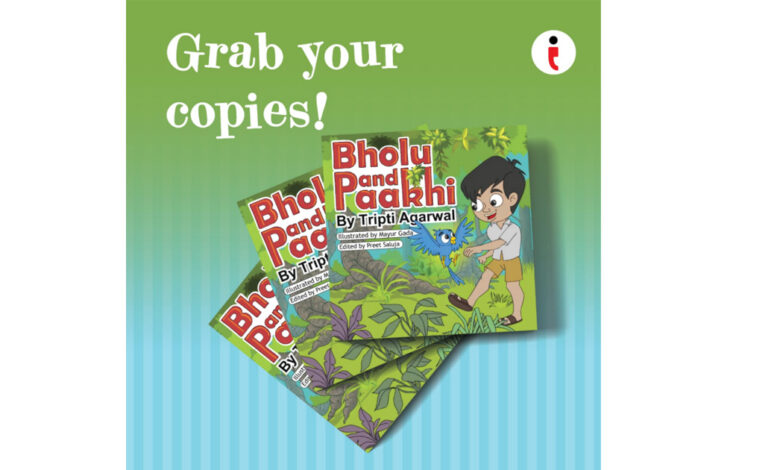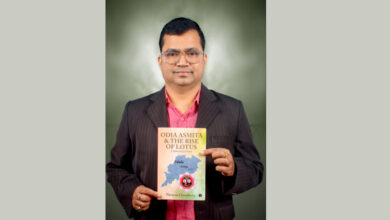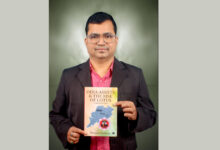Bholu and Paakhi – A Jungle Adventure About Courage, Friendship, and the Magic of Childhood

By Tripti Agarwal
Bholu and Paakhi is a heartwarming tale of bravery, adventure, and the unbreakable bond of friendship. When little Bholu sets out on a daring journey through a dense jungle to reach his beloved grandmother, he faces many obstacles—but he’s not alone. With the help of a wise and feathery companion, Paakhi, Bholu overcomes fears and finds strength he never knew he had.
This beautifully illustrated story is a celebration of nature, determination, and the warmth of family ties, created especially for young readers who love a good adventure with a meaningful message.
If you’re looking for a book that blends adventure, emotional connection, cultural richness, and gentle life lessons—Bholu and Paakhi is for you and the children you care about.
1. What inspired you to begin writing for children, and how do you ensure your stories truly connect with them?
My journey into writing for children began quite organically—it was born out of bedtime stories with my daughter. What started as impromptu tales to entertain her quickly became a cherished ritual. Her joy, curiosity, and laughter were all the inspiration I needed to keep going. Even now, at six years old, she continues to enjoy these imaginative stories—though she often says, “This can’t be real, you’re just making it up!” And she’s right! But that’s the beauty of storytelling for kids: it allows you to blend creativity with wonder in a way that sparks imagination while still making them feel understood.
2. Children’s books often carry meaningful lessons—what core values or themes did you hope to share in your latest story?
Through the journey of Bholu and his feathered friend Paakhi, this story gently weaves in several important values for young readers. It highlights the power of courage and determination, as Bholu steps out of his comfort zone to find his way to his beloved grandmother. The story also emphasizes the warmth of family bonds—especially the love and comfort that grandparents bring into a child’s life. And through Paakhi, a wise and helpful bird, children are encouraged to appreciate the natural world around them and recognize how nature often plays a silent but powerful role in our lives. It’s a story that blends adventure, emotion, and gentle life lessons in a way children can connect with.
3. Illustrations are key in children’s literature—how did working with your illustrator bring your story to life, and what was that process like?
Absolutely—illustrations are vital in children’s books. They do more than just complement the story; they help bring it to life in a way that words alone often can’t. For young readers, visuals are a powerful tool to connect with the story emotionally and imaginatively. When children see what they’re reading, and it mirrors what they’re imagining, the magic truly begins.
Working with Mayur, the illustrator of Bholu and Paakhi, and Preet Saluja, our creative editor, was a truly enriching experience. They helped transform my vision—something that lived only in my heart and mind—into a vibrant, visual journey on paper. Mayur was incredibly patient and detailed, even going through multiple iterations to get the smallest details just right—like making Bholu’s grandmother look like a warm, familiar Indian nani with her bindi, sindur, and jhumkas, yet keeping her appearance simple and real.
I still remember how Preet envisioned a lively village backdrop—with a well, a hut, animals, and farmland—and how beautifully Mayur brought that world to life. Each page of Bholu and Paakhi is the result of thoughtful collaboration, honest conversation, and a shared desire to make the story feel both magical and relatable.
4. How do you balance fun and learning when creating stories that both entertain and educate young readers?
For me, learning doesn’t always have to come from big lessons—it often hides in the tiniest, most magical moments. I believe when we live simply and observe closely, life itself becomes the best teacher. That’s exactly what I try to bring into my stories.
In Bholu and Paakhi, learning is tucked gently into the fun. For instance, there’s a jungle scene where animal sounds are written near the animals. So when a little one points to the lion and proudly says, “Roar!”—they’re smiling, engaging, and learning all at once. It’s these small, joyful discoveries that make reading an adventure. My hope is that children don’t even realize they’re learning—they just feel like they’re having a great time with the story.
5. Your characters feel very relatable—how do you develop them in a way that resonates with children, and do they reflect any personal childhood experiences?
Absolutely—they do! When I create a story, it always begins with imagination, but it’s deeply rooted in core values like love, respect, and honesty. Many of my characters are inspired by real people—people I’ve known, especially in their childhood. In a way, they’re a blend of my memories and the emotions I carry from my own growing-up years.
So yes, my childhood experiences play a big role. The feelings of wonder, mischief, warmth, and even the simple joys I once felt as a child often find their way into the characters I write. I think children connect with them because they’re real at heart—just like the kids reading the story.
6. With so much digital content available today, what role do you believe children’s books play in cultivating a love for stories and reading?
In today’s digital age, children are surrounded by screens and instant entertainment. Children’s books offer a valuable alternative that encourages imagination and focused engagement. The love for reading is best nurtured in early childhood, and when children are given interesting and visually appealing books, they are more likely to develop a genuine interest in reading. These books not only help reduce screen time but also foster a lasting love for stories and storytelling, which can grow into a lifelong habit of reading and also nudges their creative abilities.
7. Writing for young readers requires a special touch—how do you craft language and tone that engages them while also encouraging growth and understanding?
Children today are far more aware and cognitively advanced than we were at their age. A five- or six-year-old now often demonstrates the curiosity and understanding we associated with teenagers. However, children are still children—they see the world through wonder, imagination, and a unique sense of logic.
When I write for young readers, I don’t simplify the language to the point of underestimating them. Instead, I aim to strike a balance—using vocabulary that gently challenges them while remaining relatable and engaging. I weave stories that reflect their current world—full of technology and fast-paced changes—yet connect them to timeless values, traditions, and emotions. This blend allows my writing to grow with them, nurturing not just their reading skills, but also their sense of identity and imagination.
8. Families and educators often help shape children’s reading habits—how do you see your books being used at home or in the classroom?
At homes, I want my stories to become a part of bedtime rituals and cozy moments of togetherness, something that the child looks forward to. Whether it’s a laugh shared over a silly character or a pause to talk about a life lesson, I aim for my books to strengthen that special connection between the child, the reader, and the story.
In educational settings, I envision my stories being used not just to improve reading skills, but also to spark discussions around values like empathy, kindness, curiosity, and resilience. Teachers can use the characters and plots as a springboard for activities—whether it’s creative writing, role-play, or exploring cultural themes. I believe children’s books are powerful tools for both learning and bonding.
Get your copy today on amazon and let the adventure begin!








